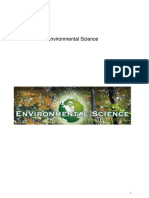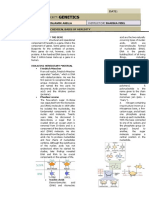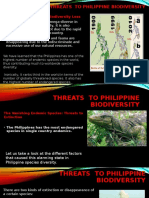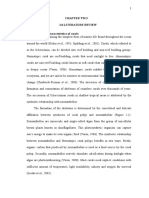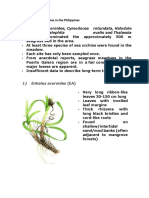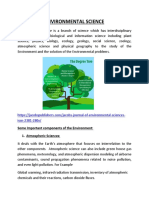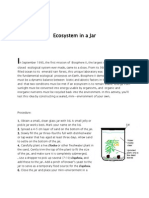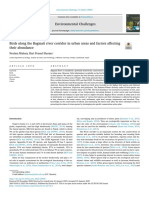Professional Documents
Culture Documents
Module 1 - Introduction To General Ecology
Module 1 - Introduction To General Ecology
Uploaded by
Nelzen Garay0 ratings0% found this document useful (0 votes)
1K views6 pages1. Ecology is the scientific study of interactions between organisms and their environments. It examines distribution, abundance, and relationships between living things within an ecosystem.
2. The history of ecology began with early philosophers like Aristotle and Theophrastus observing species relationships, but truly emerged in the 19th century with experiments like the Park Grass Experiment.
3. In the 20th century, ecology developed as a modern science through the work of scientists like Arthur Tansley, Henry Chandler Cowles, G. Evelyn Hutchinson, and Eugene Odum, who studied ecosystems, environmental influences on landscapes, and energy flows within biological systems.
Original Description:
Module
Original Title
MODULE 1_INTRODUCTION TO GENERAL ECOLOGY
Copyright
© © All Rights Reserved
Available Formats
PDF, TXT or read online from Scribd
Share this document
Did you find this document useful?
Is this content inappropriate?
Report this Document1. Ecology is the scientific study of interactions between organisms and their environments. It examines distribution, abundance, and relationships between living things within an ecosystem.
2. The history of ecology began with early philosophers like Aristotle and Theophrastus observing species relationships, but truly emerged in the 19th century with experiments like the Park Grass Experiment.
3. In the 20th century, ecology developed as a modern science through the work of scientists like Arthur Tansley, Henry Chandler Cowles, G. Evelyn Hutchinson, and Eugene Odum, who studied ecosystems, environmental influences on landscapes, and energy flows within biological systems.
Copyright:
© All Rights Reserved
Available Formats
Download as PDF, TXT or read online from Scribd
Download as pdf or txt
0 ratings0% found this document useful (0 votes)
1K views6 pagesModule 1 - Introduction To General Ecology
Module 1 - Introduction To General Ecology
Uploaded by
Nelzen Garay1. Ecology is the scientific study of interactions between organisms and their environments. It examines distribution, abundance, and relationships between living things within an ecosystem.
2. The history of ecology began with early philosophers like Aristotle and Theophrastus observing species relationships, but truly emerged in the 19th century with experiments like the Park Grass Experiment.
3. In the 20th century, ecology developed as a modern science through the work of scientists like Arthur Tansley, Henry Chandler Cowles, G. Evelyn Hutchinson, and Eugene Odum, who studied ecosystems, environmental influences on landscapes, and energy flows within biological systems.
Copyright:
© All Rights Reserved
Available Formats
Download as PDF, TXT or read online from Scribd
Download as pdf or txt
You are on page 1of 6
BIOL 103: GENERAL ECOLOGY
MODULE 1: INTRODUCTION TO GENERAL ECOLOGY
2ND SEMESTER | S.Y. 2021-2022 TRANSCRIBED BY: KATE LINDSAY MONTESCLAROS
LECTURER: MR. ARCHIE ALONG
ECOLOGY DEFINITIONS ecosystems can change quickly while some
❖ Ecology is an environmental science in its most remain constant over longer periods.
literal sense – the study of environments and the
A HISTORY OF ECOLOGY
entities within it.
❖ The word “ecology” comes from the Greek and
means “house study” or “living relations study”. ANTIQUITY TO 1900
That essentially defines what it is – the study of ❖ The philosophy behind the various and
relationships between those who occupy a sometimes disparate sciences emerged in the late
home. 19th century out of the growing interest in natural
❖ Ecology is the scientific study of interactions sciences – botany, zoology, and
which determine distribution and abundance of environmentalism mostly.
organisms (Krebs, 1792) ❖ Some argue that awareness of species and their
❖ Ecology deals with the prediction of biomass, relationships began with Aristotle, although his
productivity and diversity (Peters, 1980) writings on the matter are largely lost.
❖ Ecology deals with the description, explanation ❖ Aristotle’s student – Theophrastus described
and prediction of individuals, populations, and relationships between plants and animals but this
communities in space and time (Begon, Harper was from a philosophical rather than a scientific
and Townsend, 1986) perspective.
❖ The first true ecological study as we would
WHAT IT IS, WHAT IT ISN’T
understand it is arguably the Park Grass
❖ Ecology studies organic life, examining such
Experiment which began in 1856 by John B.
elements as spatial distribution (local or general)
Lawes and Joseph H. Gilbert, and to date in 2018,
abundance and their relationship with the
is ongoing.
environment.
➢ This includes their interaction with other
organisms within that environment –
essentially their “interrelatedness” as a
functioning network.
❖ It is considered a form of environmentalism and it
is usually associated with these sciences, but it
also includes aspects of biology, botany, zoology,
genetics, bacteriology, chemistry and physics.
➢ Ecology is about biodiversity in a given
environment. It has as much in common with
physiology, behavioral sciences and the
evolutionary sciences as it has with
environmental sciences in concerning time
❖ Two of Charles Darwin’s contemporaries also
and space.
made their own contributions.
❖ Its main areas include:
❖ His friend Alfred Russell Wallace looked at the
➢ The process that makes up biological life
geography of animal species. There was a growing
including adaptation
movement within the biological sciences that
➢ Distribution, abundance and spatial
recognized how species did not exist in a bubble –
concentration, and biodiversity
that they were dependent on each other.
➢ How and why ecosystems begin or are
changed when subject to external pressures
➢ Changes to and movement of, energy and
materials through an ecosystem. Some
❖ Arthur Tansley coined the term “ecosystem”.
Tansley’s important work was in presenting
ecology as a philosophy. This alone perhaps
permitted its adoption into the theories of many
scientific disciplines.
❖ Also, in the early part of the 20th century, American
botanist Henry Chandler Cowles effectively
founded the concept of “dynamic ecology”. His
work demonstrated how environmental influences
❖ The second contemporary was Johannes Eugenius change a landscape; unlike his contemporary
Warming. botanist, he was largely interested in landscape
❖ For the first time, the change as an influencer of botanical profiles.
scientific community started
to consider the importance of
environmental factors on the
biological systems within it.
Warming is now considered to
have created Botanical
Geography (known also as
biogeography and today as a
division of ecology) and contributed greatly to the
modern discipline.
20TH CENTURY TO THE MODERN ERA
❖ Tansley’s and Cowles’ work broadened the scope f
❖ This was when the term “biosphere” was coined
ecology.
and the recognition of the strict chemical
❖ Also, in the first half of the century, Charles Elton
balances required for life to evolve and sustain
began animal ecology, but the real breakthrough
itself was identified.
was the work of British-born ecologist G. Evelyn
❖ Vladimir I. Vernadsky, a Russian geologist who
Hutchinson and his work across New England.
defected to France around the time of the Russian
❖ Under his work, ecology became an applied
Revolution, wrote extensively about the
science as well as theoretical. His work impacted
biosphere in the aptly titled study “The
many subdisciplines including biogeochemistry
Biosphere” published in 1926.
(the impact of geological, biological and chemical
❖ He did not coin the term. That honor goes to a
actions on the environment), entomology
fellow geologist by the name of Eduard Suess, an
(insects), genetics, limnology (inland water
Austrian, in 1875. The concept of the idea of our
bodies), and population dynamics theory.
planet and the biological systems within it making
up part of a whole was born.
FATHER OF ECOLOGY - Identified many rules of heredity. These rules
❖ ERNST HAECKEL is the FATHER OF ECOLOGY and determine how traits are passed through
a writer of popular science. generations of living things.
❖ HANS DRIESCH is a student of Haeckel and the Carl Ludwig Willdenow (1765-1812)
author of A History and Theory of Vitalism. - One of the early plant geographers.
❖ C.K. OGDEN translates Driesch’s book in 1914. - He pointed out that similar climates
supported vegetation similar in form,
even though the species were different.
❖ EUGEN P. ODUM is the FATHER OF MODERN
ECOLOGY. Freidrich Heinrich Alexander Von
Humboldt (1769-1859)
Ecology is the study of structure and function of - Plant geographer
nature or the study of ecosystems (Odum, 1972) - He spent 5 years exploring Latin
America, including the Orinoco and
Amazon Rivers.
OTHER SCIENTISTS
- He correlated vegetation with environmental
❖ Ecology was originally coined in 1866 in General
characteristic and coined the term Plant Association.
Morphology, a book on biology and philosophy by R.A Lindeman (1915-1942)
Prof. Ernst Haeckel. - He traced “energy-available”
➢ Haeckel defined it as “the comprehensive relationship within a lake community.
science of the relationship of the organism to - His 1942 paper, “The Trophic-Dynamic
the environment.” Aspects of Ecology”, marked the
❖ The first usage was in a letter by Henry David beginning of ecosystem ecology, the
Thoreau in 1858. study of whole living systems.
Thomas Malthus (1766-1834)
Jean Baptiste de Lamarck (1744-1829) -An economist
evolution by acquired characteristics - Advanced the principle that
populations grow in a geometric
fashion, doubling at regular intervals
Charles Darwin (1809-1882) until the outstrip the food supply.
-Considered as the founder of the William Wheeler – studied the behavior of ants.
modern theory of evolution Charles Carpenter – studied the behaviors of South
-developed the Natural Selection Theory American Monkeys
- In 1859, he published “On the Origin of Konrad Lorenz and Niko Tindergen – gave a strong
Species by Means of Natural Selection” importance to the field with their pioneering studies
Alfred Russel Wallace (1823-1913) in the role of imprinting and instinct in the social life
- He was a British naturalist, explorer, of animals, particularly birds and fishes.
geographer, anthropologist, and
biologist.
- He is best known for independently THE ECONOMY OF NATURE
conceiving the theory of evolution ❖ The investigation of the total relations of the
through natural selection; hispaper on the subject animal both its inorganic and its organic
was ointly published with some of Charles Darwin’s environment; including, above all, its friendly and
writings in 1858. inimical relations with those animals and plants
- FATHER OF BIOGEOGRAPHY with which it comes directly or indirectly into
- He made many other contributions to the
contact.
development of evolutionary theory besides being
➢ In a word, ecology is the study of all complex
co-discoverer of natural selection; the concept of
warning coloration in animals, and the Wallace interrelations referred to by Darwin as the
effect, (hypothesis on how natural selection could conditions of the struggle for existence.
contribute tospeciation by encouraging the DIFFERENT WAYS OF APPROACHING THE STUDY
development of barriers against hybridization.) OF ECOLOGY
❖ Kinds of Ecology as defined by concept and
Gregor Johann Mendel (1822-1884)
perspective
- Founded the science of genetics
➢ Landscape
- FATHER OF GENETICS
➢ Ecosystem
➢ Physiological
➢ Behavioral among organisms and parts of the
➢ Community environment.
❖ Kinds of Ecology as defined by organism ➢ Physiological – Physiological ecology is the
➢ Plant study of how individual organisms interact
➢ Animal with their environment to carry out the
➢ Microbe biochemical processes and express the
➢ Zooplankton behavioral adaptations that accomplish
➢ Human homeostasis and survival.
➢ Deer ➢ Behavioral – The goal of behavioral ecology is
➢ Tree to understand how a plant or animal’s
❖ Kinds of Ecology as defined by habitat behavior is adapted to its environment. That
➢ Terrestrial is, behavior is understood to be the result of
➢ Lakes and streams (limnology) an evolutionary process.
➢ Marine (oceanography) ➢ Population - Population ecology focuses on
➢ Arctic how and why populations change in size and
➢ Rain Forest location over time.
➢ Benthic thermal vents ➢ Community – Community ecologists examine
➢ Urban the patterns and interactions seen in groups,
❖ Kinds of Ecology as defined by application or aggregations, of different species. The
➢ Theoretical distribution of species is influenced both by
➢ Conservation biological interactions (such as predation and
➢ Agricultural competition) and by environmental factors
➢ Public Policy (such as tempt, water and nutrient
➢ Academic availability)
➢ Management
TECHNIQUES SPECIFIC TO DIFFERENT KINDS OF
➢ Restoration
ECOLOGY
ECOLOGICAL CONCEPTS: THE KINDS OF ECOLOGY ❖ Landscape – Satellites, photos, maps, and
❖ Ecology – the study of the relationships, computers are essential, especially for geographic
distribution, and abundance of organisms, or information system (GIS)
groups of organisms, in an environment ❖ Ecosystem – Calorimeter pressure bomb,
❖ People and Nature – All environments change, quantitative chemical analysis
and people have been important forces shaping ❖ Physiological – Respirometer, treadmill, infrared
these changes for only a tiny fraction of Earth’s gas analyzer (IRGA), stable isotope chemistry,
history. light sensors, thermocouples
➢ Historical ecology examines these ❖ Population – Sampling traps, computers
environmental changes by focusing on ❖ Behavioral – Video equipment. Event recorder,
questions about how humans have affected binoculars, radiotags, geographic position
the environment, how our cultural attitudes satellites, computer, DNA fingerprinting
affect how we do ecology, and the history of ❖ Community – Quadrat sampling, species
how humans have attempted to manage the identification book, enclosures
environment.
IMPORTANCE OF ECOLOGY
❖ Landscape – the landscape can be thought of as
❖ Ecology is important because of the insights it
being made up of different patches, characterized
provides about the ways in which people and
by different organisms and environments.
nature depend on one another.
❖ Ecosystem – Ecosystem ecology is the study of the
❖ Understanding the workings of ecological systems
interactions of organisms with the transport and
more completely allows for predictions about the
flow or energy and matter.
ways human activities affect the health of the
➢ Ecosystem size and shape depends on the
earth over time.
specific questions being asked about energy
❖ LEVELS OF ORGANIZATION – is a hierarchy of
flow or chemical cycling.
organization in the environment
➢ The “system” part of an ecosystem is a
description of how energy or matter moves
HOW TO STUDY ECOLOGY? THE EFFECTS OF SCALE
1. The technology does not exist to recreate ❖ In spatial ecology, scale refers to the spatial extent
ecosystems or even individual species. of ecological processes and the spatial
2. Having convinced governments of the value of interpretation of the data. The response of an
biodiversity, we now have to determine just organism or a species to the environment is
how far ecosystems can be altered before the particular to a specific scale and may respond
cease to function in an acceptable way. differently at a larger or smaller scale.
3. Good arguments can be made against ❖ Scale is continuum (a range or series of things that
ecological mismanagement and loss of biotic are slightly different from each other and that
diversity on moral and ethical grounds. exist between two different possibilities)
MORAL AND ETHICAL GROUNDS
❖ Tom Regan – A philosopher, argue that animals
are to be treated with respect because they have
a life of their own and therefore have value apart
from anyone else’s interests.
❑ Can animals or plants ‘count’ in their own
right?
❑ Can wildlife count for more than humans in
some cases?
❖ Perhaps one of the soundest arguments for
conservation of biodiversity is that, at the least,
it keeps our options open for the future.
THE SCIENTIFIC METHOD 5 MAJOR POINTS (CONTINUUM TO BE
1. Question RECOGNIZED)
2. Hypothesize 1. A space occupied by a single individual sessile
3. Experiment organism or a space in which mobile organism
4. Observe & record spends its entire life.
5. Analyze 2. A local patch occupied by many individuals.
6. Share Results 3. A region large enough to include many patches
❖ For many years, scientists have tried to correct or population linked by dispersal.
the idea that the scientific method is the only 4. A space large enough to contain a closed
correct way to do science. ecosystem (one receiving no migration) – an
❖ This “a method of science” has a strong hold in unlikely scenario in practice.
science teaching but is not science. 5. A biogeographic scale, large enough to
❖ Posters are still hung in science classrooms listing encompass different habitats and climates.
the steps of the scientific method and are still
EFFECTS OF SCALE ON ECOLOGICAL
used to judge students’ procedures in science fair INVESTIGATIONS
competitions. 1. Individual space
❖ There is no logical or procedural method by which ➢ Physiological ecology, socio-biology, foraging
the pattern is suggested because If there is, then ecology, reproductive biology
it goes against the creative nature and element of 2. Local patch/ecological neighborhood
science. ➢ Predation, herbivory, parasitism, and
❖ Scientific papers seem to follow the scientific pollination
method but are reconstructed to account for key 3. Regional scale
elements of the study. ➢ Immigration, emigration, outbreaks, habitat
❖ The actual events for any investigations vary preference
considerably and may take many wrong turns and 4. Closed system
dead ends. ➢ Nutrient cycling, ecological energetics
5. Biogeographical scale
➢ Climatic limits, evolutionary ecology
❖ LIFE
❑ Order
❑ Regulation
❑ Energy Processing
❑ Growth and Development
❑ Reproduction
❑ Response to the environment
❑ Evolutionary adaptation
EVOLUTIONARY HISTORY: HOW DID LIFE FORM?
❖ Theories on the Origin of Life:
1. Spontaneous Generation
2. Primordial Soup
3. External Sources
HOW VARIATION ORIGINATES?
❖ It is genetic variation that can produce either an
increase or a decrease in the variability of a
population.
❖ In all organisms (except RNA viruses), the genetic
material is DNA (deoxyribonucleic acid)
❖ In prokaryotes, the DNA exists in the form of a
single circular chromosome, in eukaryotes it is
arranged into a set of linear chromosomes that
reside in the cell nucleus.
HOMEWORK 001
1. How variation is maintained without selection?
a. The Hardy-Weinberg Theorem
b. The Effects of Non-random Mating
c. Environmental variance
2. How variation is maintained with selection?
3. How much variation exists in Nature?
4. What is inbreeding?
5. What is genetic drift?
6. What is bottleneck effect?
You might also like
- The External Anatomy of Farm AnimalsDocument20 pagesThe External Anatomy of Farm AnimalsAutumn shield100% (3)
- An Introduction To Corporate Environmental Management Striving For SustainabilityDocument384 pagesAn Introduction To Corporate Environmental Management Striving For Sustainabilitybushra aliNo ratings yet
- Bio 100 Botany Course SyllabusDocument11 pagesBio 100 Botany Course Syllabusnourshamsia barosa100% (1)
- Science7-Q2-Mod8 v1Document34 pagesScience7-Q2-Mod8 v1Meryl Gallardo100% (1)
- LECTURE 1-Evolutionary and Ecological Perspective of ZoologyDocument29 pagesLECTURE 1-Evolutionary and Ecological Perspective of ZoologyAngelica Rose EspornaNo ratings yet
- Pee (Module 4) - Aquatic EcosystemDocument28 pagesPee (Module 4) - Aquatic EcosystemToni Rose Hernandez LualhatiNo ratings yet
- Tilapia Dissection and Guide: Lab Questions #1: Tilapia Belong To What Class of Bony Fish?Document9 pagesTilapia Dissection and Guide: Lab Questions #1: Tilapia Belong To What Class of Bony Fish?Alain Salvador100% (1)
- Science-Related Related Issues and Problems in The CountryDocument3 pagesScience-Related Related Issues and Problems in The CountryRonalyn PaunalNo ratings yet
- Environmental Science ModuleDocument287 pagesEnvironmental Science ModuleCiarel VillanuevaNo ratings yet
- Biodiversity Powerpoint STSDocument24 pagesBiodiversity Powerpoint STSsean go100% (2)
- Final Exam GE10 People and Earths Ecosystem by CEAlarbaDocument8 pagesFinal Exam GE10 People and Earths Ecosystem by CEAlarbachris ian100% (1)
- List of Some Common Weeds in The PhilippinesDocument8 pagesList of Some Common Weeds in The PhilippinesRhema B. Bangcas100% (2)
- Site Characterization and SelectionDocument29 pagesSite Characterization and Selectionsamuel pineda100% (1)
- Nature AND Importance of AgrcultureDocument54 pagesNature AND Importance of Agrculturegemini googleNo ratings yet
- Kawayan Kiling ProposalDocument13 pagesKawayan Kiling ProposalJanine CortiguerraNo ratings yet
- NSCI 111 UNIT 3 & 4 NotesDocument11 pagesNSCI 111 UNIT 3 & 4 NoteskAgEyAmANo ratings yet
- Lecture 1 Introduction To EcologyDocument16 pagesLecture 1 Introduction To EcologyMonica BañasNo ratings yet
- History of The Philippine AgricultureDocument14 pagesHistory of The Philippine AgricultureAure ReidNo ratings yet
- Bot1 General Botany SyllabusDocument9 pagesBot1 General Botany Syllabusstephen carlosNo ratings yet
- Butterfly-Farming The Flying Gems by Labay PIFGEX 2009Document30 pagesButterfly-Farming The Flying Gems by Labay PIFGEX 2009Anonymous HXLczq375% (4)
- Activity 1. EcologyDocument6 pagesActivity 1. EcologyRemylyn FeraerNo ratings yet
- Ecology - Reviewer MidtermDocument7 pagesEcology - Reviewer MidtermMaria Nina Tanedo100% (1)
- 04-Chemical Basis of HeredityDocument10 pages04-Chemical Basis of HeredityBen Abella100% (1)
- Development of AgricultureDocument18 pagesDevelopment of AgricultureFriences Joyce Dela Cerna100% (1)
- Threats To Philippine BiodiversityDocument18 pagesThreats To Philippine BiodiversityRhieza Perez Umandal100% (2)
- Dark Astronomy Thesis by SlidesgoDocument8 pagesDark Astronomy Thesis by SlidesgoGracey DaponNo ratings yet
- Mod1 Sts Module 1Document9 pagesMod1 Sts Module 1Marviane Sigrid GayotinNo ratings yet
- Module 8 Environmental EthicsDocument4 pagesModule 8 Environmental EthicsNyssa GNo ratings yet
- Name Picture Function: Jan Chrispian Mirasol Riza Mae Naria 1BSPH2Document9 pagesName Picture Function: Jan Chrispian Mirasol Riza Mae Naria 1BSPH2Jan Chrispian MirasolNo ratings yet
- Filipino Biologists and Their ContributionsDocument2 pagesFilipino Biologists and Their ContributionsAlbert Delos Santos100% (1)
- AG EXT Chapter 9Document5 pagesAG EXT Chapter 9Oliver Talip100% (1)
- Registered Crop Varieties: Yield (T/ha) 100-Seed Weight (G) DS WS DS WS 0.86Document21 pagesRegistered Crop Varieties: Yield (T/ha) 100-Seed Weight (G) DS WS DS WS 0.86Esther Suan-LancitaNo ratings yet
- Exercise No.1 Soil Sampling For Chemical and Physical AnalysesDocument22 pagesExercise No.1 Soil Sampling For Chemical and Physical AnalysesMark MatthewNo ratings yet
- Literature ReviewDocument19 pagesLiterature ReviewNasrul Safwan MTNo ratings yet
- Module 4 Non Fish Aquatic ResourcesDocument30 pagesModule 4 Non Fish Aquatic ResourcesErine Contrano100% (1)
- Research Golden SnailDocument39 pagesResearch Golden SnailArman SerranoNo ratings yet
- Soil Fertility Conservation and Management ModuleDocument169 pagesSoil Fertility Conservation and Management Modulehyorin628No ratings yet
- AI8201 r17 Principles and Practices of Crop ProductionDocument1 pageAI8201 r17 Principles and Practices of Crop Productionvimbee alipoon100% (1)
- Structure of GrasshopperDocument18 pagesStructure of GrasshopperMd Atikur AminNo ratings yet
- Lesson 2. Beef Production Systems in The PhilippinesDocument1 pageLesson 2. Beef Production Systems in The PhilippinesLucy May DuriaNo ratings yet
- Common Seagrass Species in The PhilippinesDocument10 pagesCommon Seagrass Species in The PhilippinesWilliam A. Laride0% (1)
- A Flora of ManilaDocument503 pagesA Flora of ManilaKatrina IsabelNo ratings yet
- Factor Influencing World Distribution of Plants and AnimalsDocument14 pagesFactor Influencing World Distribution of Plants and AnimalsNilesh Khadse75% (4)
- Issues in BiotechnologyDocument14 pagesIssues in BiotechnologyAlkhair Sangcopan100% (2)
- Practical Research Group 7Document23 pagesPractical Research Group 7Hermelita MarbebeNo ratings yet
- AS 122 Principles of Animal ScienceDocument7 pagesAS 122 Principles of Animal ScienceChristian Dave RoneNo ratings yet
- Postharvest Handling Definition of TermsDocument8 pagesPostharvest Handling Definition of TermsApril Ervas100% (1)
- Sweetpotato VarietiesDocument15 pagesSweetpotato VarietiesALL ABOUT PAGEANTARY100% (1)
- Fisheries Extension: 2.1 The Background and Meaning of ExtensionDocument21 pagesFisheries Extension: 2.1 The Background and Meaning of ExtensionKenn Dagpin TorculasNo ratings yet
- Internal Parts of A FishDocument2 pagesInternal Parts of A FishBohna FranciscoNo ratings yet
- Famous Filipinos in The Field of ScienceDocument32 pagesFamous Filipinos in The Field of ScienceKristofer Ryan Ensano50% (2)
- Module 1-Introduction To Soil ScienceDocument5 pagesModule 1-Introduction To Soil ScienceJr BagaporoNo ratings yet
- Pandangan & Sardani - Activity-6-Isolation-Of-MicroorganismsDocument2 pagesPandangan & Sardani - Activity-6-Isolation-Of-MicroorganismsPandangan MatiynNo ratings yet
- Lecture - 1 (Ecology PPT) 23-07-2015Document36 pagesLecture - 1 (Ecology PPT) 23-07-2015RAJESH KUMAR BARANWAL33% (3)
- Environmental ScienceDocument5 pagesEnvironmental ScienceKevin linsonNo ratings yet
- Scientific Name: Desmodium Cinereum Common Names: Rensoni. Tickclover CharacteristicsDocument21 pagesScientific Name: Desmodium Cinereum Common Names: Rensoni. Tickclover CharacteristicsHeízielle100% (2)
- Laboratory Exercise #2Document6 pagesLaboratory Exercise #2Arfie Lowie PujedaNo ratings yet
- IN SUNNY SPAIN, 1882-85: "My Country, My Love, My People, I Leave You Now, You Disappear, I Lose Sight of You"Document4 pagesIN SUNNY SPAIN, 1882-85: "My Country, My Love, My People, I Leave You Now, You Disappear, I Lose Sight of You"Mary Claire ComalaNo ratings yet
- Chapter IDocument44 pagesChapter IEllen Mae PormanesNo ratings yet
- Pests of Field Crops and Pastures: Identification and ControlFrom EverandPests of Field Crops and Pastures: Identification and ControlPT BaileyNo ratings yet
- The Ecosystem Concept: A Search For OrderDocument10 pagesThe Ecosystem Concept: A Search For Orderdgol32375No ratings yet
- History of EcologyDocument6 pagesHistory of EcologyNero BreakalegNo ratings yet
- Blue Simple Abstract Table of ContentsDocument2 pagesBlue Simple Abstract Table of ContentsNelzen GarayNo ratings yet
- Garay - Paul - FBS 113 Exercise 2Document4 pagesGaray - Paul - FBS 113 Exercise 2Nelzen GarayNo ratings yet
- Quiz #2 - BreakevenDocument1 pageQuiz #2 - BreakevenNelzen GarayNo ratings yet
- SummativeDocument1 pageSummativeNelzen GarayNo ratings yet
- CFMP Danice Babor Fsuu Ma 43Document28 pagesCFMP Danice Babor Fsuu Ma 43Nelzen GarayNo ratings yet
- Pp-Soil Origin and DevelopmentDocument176 pagesPp-Soil Origin and DevelopmentNelzen GarayNo ratings yet
- Era-Forex AssessmentDocument28 pagesEra-Forex AssessmentNelzen GarayNo ratings yet
- TAX Midterm Mr-Dizon-ExerciseDocument2 pagesTAX Midterm Mr-Dizon-ExerciseNelzen GarayNo ratings yet
- Quiz #3 - CVP AnalysisDocument1 pageQuiz #3 - CVP AnalysisNelzen GarayNo ratings yet
- Financial StatementsDocument40 pagesFinancial StatementsNelzen GarayNo ratings yet
- Module 1 - Introduction To PrepositionsDocument2 pagesModule 1 - Introduction To PrepositionsNelzen Garay0% (1)
- MS 111 - PrelimDocument4 pagesMS 111 - PrelimNelzen GarayNo ratings yet
- Module 1: Overview of Statistics For Life SciencesDocument3 pagesModule 1: Overview of Statistics For Life SciencesNelzen GarayNo ratings yet
- Module 1 - Introduction To EcologyDocument6 pagesModule 1 - Introduction To EcologyNelzen GarayNo ratings yet
- Situation No.1: You Won As President in The Supreme Student Government Election 2021Document2 pagesSituation No.1: You Won As President in The Supreme Student Government Election 2021Nelzen GarayNo ratings yet
- Risk Assessment Process For Ayala Land Inc. v22Document11 pagesRisk Assessment Process For Ayala Land Inc. v22Nelzen GarayNo ratings yet
- Module 1 - Nomenclature of Organic Compounds Lab 1Document6 pagesModule 1 - Nomenclature of Organic Compounds Lab 1Nelzen GarayNo ratings yet
- IC-RES 130 - ELEMENTS OF RESEARCH-Group 2Document2 pagesIC-RES 130 - ELEMENTS OF RESEARCH-Group 2Nelzen GarayNo ratings yet
- Background of The StudyDocument4 pagesBackground of The StudyNelzen GarayNo ratings yet
- 21st Century Summative Test 1st-4thDocument2 pages21st Century Summative Test 1st-4thNelzen GarayNo ratings yet
- 21st Century Quarter 2-Week 2Document1 page21st Century Quarter 2-Week 2Nelzen GarayNo ratings yet
- Organic FarmingDocument33 pagesOrganic FarmingAa100% (2)
- Gomes Et Al 2014Document8 pagesGomes Et Al 2014Stephanie Menezes RochaNo ratings yet
- Final Draft Whitepaper With Track Changes Accepted SharksDocument10 pagesFinal Draft Whitepaper With Track Changes Accepted Sharksapi-676366041No ratings yet
- A Conceptual Framework For Environmental Justice Based On Shared But Differentiated ResponsibilitiesDocument58 pagesA Conceptual Framework For Environmental Justice Based On Shared But Differentiated ResponsibilitiesPablo Aguayo WestwoodNo ratings yet
- Fish Culture CLMDocument43 pagesFish Culture CLMGideonCavidaNo ratings yet
- Ecosystem in A JarDocument2 pagesEcosystem in A JarRamon GasgasNo ratings yet
- Wild Ones Native Garden Design ST LouisDocument3 pagesWild Ones Native Garden Design ST LouisAlyssa JenningsNo ratings yet
- Life Sciences SyllabusDocument4 pagesLife Sciences SyllabusConflicted ConundrumNo ratings yet
- Farrell, Twining-Ward - 2005 - Seven Steps Towards Sustainability - UnknownDocument14 pagesFarrell, Twining-Ward - 2005 - Seven Steps Towards Sustainability - Unknownita faristaNo ratings yet
- English 1st Pu Model Question PaperDocument3 pagesEnglish 1st Pu Model Question PaperShivakumar Kumar0% (1)
- AP Simpson Diversity Index Lab 11-12Document7 pagesAP Simpson Diversity Index Lab 11-12Aiko Eleni0% (1)
- E Activity Watershed CharacteristicsDocument12 pagesE Activity Watershed CharacteristicsRaymar Macarayan0% (1)
- Hughes (2002) - Environmental IndicatorsDocument21 pagesHughes (2002) - Environmental IndicatorsSuryo KusumoNo ratings yet
- 18.analytic Evaluation of The Case Studies of Rivers and Reservoirs ACET.000622Document10 pages18.analytic Evaluation of The Case Studies of Rivers and Reservoirs ACET.000622nadir184No ratings yet
- Blakemore Et AlDocument9 pagesBlakemore Et AlRetnosititafriziahNo ratings yet
- 1 s2.0 S2667010023000082 MainDocument9 pages1 s2.0 S2667010023000082 MainEntertainment NeedsuNo ratings yet
- PHD Thesis Topics in GeographyDocument4 pagesPHD Thesis Topics in GeographyWriteMyPaperCheapBillings100% (2)
- Summative Test Q2-2Document2 pagesSummative Test Q2-2Aila Jane Olano VestidasNo ratings yet
- Plano Verde de Sintra - CEAPDocument351 pagesPlano Verde de Sintra - CEAPpedro_arsenio100% (1)
- Kh3112749enn 002Document106 pagesKh3112749enn 002Elisabeta OprisanNo ratings yet
- Environmental Law CasesDocument18 pagesEnvironmental Law CasesKirk BejasaNo ratings yet
- Freshwater Ecosystem Final OutlineDocument13 pagesFreshwater Ecosystem Final OutlineSereneNo ratings yet
- ORF OccasionalPaper 317 BlueGreenInfrastructureDocument38 pagesORF OccasionalPaper 317 BlueGreenInfrastructureMd IbrahimNo ratings yet
- Chap 1 EcologyDocument45 pagesChap 1 EcologyCaryl Alvarado SilangNo ratings yet
- The Interactive Microbial Ocean: CommentDocument2 pagesThe Interactive Microbial Ocean: CommentOscarMavilaHerediaNo ratings yet
- India FullDocument190 pagesIndia Fullapi-295592931No ratings yet
- Ecological Footprint EssayDocument2 pagesEcological Footprint Essayggwp21No ratings yet
- Biodiversity NotesDocument29 pagesBiodiversity NotesTrishia Faith DemetrioNo ratings yet








